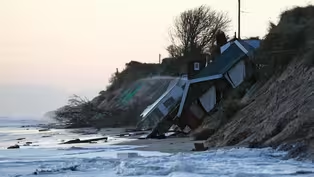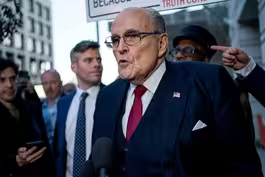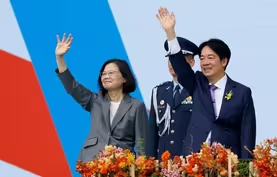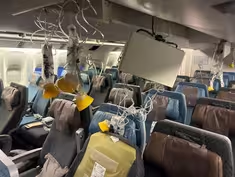
Exhibit explores humans put on display at 1904 World’s Fair
Clip: 5/21/2024 | 4m 55sVideo has Closed Captions
Exhibit explores experiences of humans put on display at 1904 World’s Fair in St. Louis
In 1904, nearly 1,200 Filipinos were brought to the U.S. to take part in the World’s Fair in St. Louis. Some worked as guides, but others were put on display. More than a century later, a new exhibit explores the impact in St. Louis and beyond. Communities correspondent Gabrielle Hays reports.
Problems playing video? | Closed Captioning Feedback
Problems playing video? | Closed Captioning Feedback
Major corporate funding for the PBS News Hour is provided by BDO, BNSF, Consumer Cellular, American Cruise Lines, and Raymond James. Funding for the PBS NewsHour Weekend is provided by...

Exhibit explores humans put on display at 1904 World’s Fair
Clip: 5/21/2024 | 4m 55sVideo has Closed Captions
In 1904, nearly 1,200 Filipinos were brought to the U.S. to take part in the World’s Fair in St. Louis. Some worked as guides, but others were put on display. More than a century later, a new exhibit explores the impact in St. Louis and beyond. Communities correspondent Gabrielle Hays reports.
Problems playing video? | Closed Captioning Feedback
How to Watch PBS News Hour
PBS News Hour is available to stream on pbs.org and the free PBS App, available on iPhone, Apple TV, Android TV, Android smartphones, Amazon Fire TV, Amazon Fire Tablet, Roku, Samsung Smart TV, and Vizio.
Providing Support for PBS.org
Learn Moreabout PBS online sponsorshipGEOFF BENNETT: In 1904, nearly 1,200 Filipinos were transported to the U.S. to take part in the World's Fair in St. Louis.
Some worked as guides, but others were put on display.
Now, more than a century later, a new exhibit explores the impact in St. Louis and beyond.
Our communities correspondent, Gabrielle Hays, has this report.
GABRIELLE HAYS: The 1904 World's Fair, 20 million visitors, the newest marvels in art, architecture, and technology, a giant ferris wheel, ice cream, and hundreds of human beings on display.
RIA UNSON, Great-Granddaughter of Ramon Ochoa: A hundred and twenty years later, there are still people who have perceptions of Filipinos as savages, as primitives.
I have gotten questions in the last year asking me if there are buildings in the Philippines.
GABRIELLE HAYS: Ria Unson's great grandfather, Ramon Ochoa, was brought to St. Louis in 1904 to be a pensionado at the fair, a sort of ambassador promoting the influence of Western culture on their home country.
RIA UNSON: So, I happened to Google his name, and this image came out with him on the steps of Festival Hall.
Now, having spent 28 years now in St. Louis, really familiar with that vista, right?
I was like, hey, that looks like the World's Fair.
GABRIELLE HAYS: Ochoa was part of the Philippine Village, the largest section of the fair, a 47-acre display designed to introduce Americans to the then-newly acquired territory.
RIA UNSON: It cost a lot of money to stage that exhibit.
It was $1.5 million in 1904.
So that's like $35 million today.
GABRIELLE HAYS: But it wasn't all about diplomacy.
Hundreds of Filipinos from different ethnic groups and tribes, along with other indigenous people from all over the world, were put on display for the amusement of white fairgoers.
RIA UNSON: That was very intentional in the sense that it was to create the optics of basically here the Igorots were on -- were displayed as savages and primitives.
And here were these pensionados, who were very Western.
We were there showing off our own people.
GABRIELLE HAYS: Seventeen people died in the Philippine Village during the seven-month-long fair, from pneumonia, malnutrition, or suicide.
Unson's voice is one of many at the new exhibit at the Missouri History Museum in St. Louis, on the very grounds where the fair took place.
On display are nearly 200 artifacts and a 16-by-25-foot replica of the fairgrounds.
It's an attempt to reexamine the complexity of the fair, says Adam Kloppe, a public historian at the museum.
ADAM KLOPPE, Missouri History Museum: People tend to fall in one of two camps about it when they talk about it.
Either they want to talk about the wonder of the World's Fair, the grandeur of the electric lights, the ferris wheel and the ice cream cone and all that, or they want to talk about the complexities of the World's Fair.
In order to understand the true impact of it as an event, you sort of have to wrap your arms around both of those ideas at the same time.
GABRIELLE HAYS: The massive event was not without scandal at the time.
Civil rights organizations pushed back about the treatment of women and people of color.
Plans For Negro day were canceled.
And some boycotted the event altogether.
Fair organizers and a local newspaper described claims of racial discrimination as sensational.
LINDA NANCE, National Association of Colored Women's Clubs: There should not have been people on display, as they were.
GABRIELLE HAYS: Linda Nance is the historian of the National Association of Colored Women's Clubs and another voice featured in the exhibit.
LINDA NANCE: I can't change what happened in 1904.
And it does not make sense for me to lament over what happened in 1904.
It does make sense for me to take a look at that and decide that, from this point, with my involvement, I can make things better.
GABRIELLE HAYS: For Ria Unson, it's an opportunity to acknowledge the whole story and for visitors to walk away with a perspective they otherwise wouldn't have.
RIA UNSON: I hope they ask more questions.
I hope that they listen to these stories and say, OK, where am I in the context of these stories?
Just asking the question like, how did their experience shape my life?
Or how can I place this, again, in history?
GABRIELLE HAYS: For the "PBS NewsHour," I'm Gabrielle Hays at the Missouri History Museum in St. Louis.
Bill Maher on book reflecting on his comedy and commentary
Video has Closed Captions
Clip: 5/21/2024 | 8m 58s | Bill Maher on his new book reflecting on decades of comedy and commentary (8m 58s)
'Climate refugees' sue Britain for failing to protect homes
Video has Closed Captions
Clip: 5/21/2024 | 7m 53s | 'Climate refugees' sue British government for failing to protect homes from climate change (7m 53s)
Giuliani, Trump allies arraigned in Ariz. electors scheme
Video has Closed Captions
Clip: 5/21/2024 | 4m 31s | Giuliani, Trump allies arraigned in Arizona fake electors scheme (4m 31s)
How Trump's alleged hush money payments led to his charges
Video has Closed Captions
Clip: 5/21/2024 | 7m 58s | How Trump's alleged hush money payments led to his charges in New York (7m 58s)
Taiwan's new president urges China to end threats
Video has Closed Captions
Clip: 5/21/2024 | 5m 37s | Taiwan's president urges China to end threats as Beijing says independence is 'dead end' (5m 37s)
Turbulence on Singapore Airlines flight kills passenger
Video has Closed Captions
Clip: 5/21/2024 | 5m 26s | Severe turbulence on Singapore Airlines flight kills passenger, injures dozens more (5m 26s)
Providing Support for PBS.org
Learn Moreabout PBS online sponsorshipSupport for PBS provided by:
Major corporate funding for the PBS News Hour is provided by BDO, BNSF, Consumer Cellular, American Cruise Lines, and Raymond James. Funding for the PBS NewsHour Weekend is provided by...

















